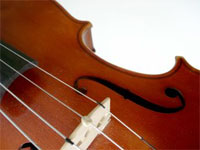Clinical
Specialties: Prolotherapy
Treating
the Pain of Playing Musical Instruments
 By Andrew Kochan M.D. By Andrew Kochan M.D.
Many musicians develop pain in one or more
joints or tendons after years of playing musical
instruments. This pain can result from performing
repetitive movements especially if the technique
used is not perfect or from overuse associated
with long hours of practice and frequent performances.
This muscle, tendon and joint pain tends to be
intermittent at first, treated easily with a
little rest, anti-inflammatory medication and
ice. Each time the pain returns it’s a
little stronger, lasts a little longer and causes
the artist more trouble. At this stage the problem
is often treated with injections of cortisone
and/or physical therapy. Eventually, the problem
can become severe enough to require surgery or
to force the sufferer to stop playing for long
periods or even into retirement.
Drs. Liu and Hayden wrote in their article “Maladies
in Musicians” published in The Southern
Journal of Medicine in 2002 that “Rest
is the only reliable treatment for overuse syndromes”.
This is not correct. There is a treatment unknown
to most physicians, chiropractors and orthopedic
surgeons which can halt and even reverse the
degenerative processes associated with overuse
syndromes and injuries from improper and/or awkward
technique.
Prolotherapy, also known as proliferant therapy,
was developed by osteopathic physicians about
sixty years ago. It is a technique that involves
stimulating the tissue to heal itself in areas
that have been damaged or weakened. How can
it do this?
The body responds to tissue injury. If there
is damage of tissue cells, as in cutting or tearing
tissue especially if associated with bleeding,
there is a chemical signal for the body to bring
in cells called macrophages to clean up the debris.
After the macrophages are finished cleaning up,
other cells called fibrocytes are attracted to
the area to lay down new collagen. Collagen is
the basic material of which tendons, ligaments,
fascia, and joint capsules are made. This process
takes weeks to months to complete. In a chronic
strain or overuse of the tendons, ligaments or
muscles despite pain being present, there is
no actual tissue “damage” from an
injury. Thus the body has no stimulus to heal
since there is no actual bleeding or tissue destruction.
Thus a chronic strain or overuse injury can last
indefinitely and no healing will occur.
The technique of prolotherapy involves injection
of a sugar water (dextrose) solution and anesthetic
into the painful, strained and weakened tissue
whether it is tendon, ligament, or joint. This
solution causes cells to implode and break
apart, thus liberating chemicals into the region
and initiating the healing process as described
earlier. Because this stimulus is rather mild,
it often needs to be repeated several times on
a biweekly basis to get the full benefit.
Musicians who play different instruments tend
to have different strains and pains. Flute
players commonly have right shoulder problems
because of the way they hold their instruments.
Clarinet and oboe players get overuse symptoms
in the web space between the thumb and index
fingers. Bassoon players frequently develop thumb
tendonitis or arthritis. All musicians are subject
to low back and neck stains and pain due to long
hours of sitting. Even musicians who play the
same instrument can have different injuries depending
on their own body shape and size, technique
and make of instrument. For example, violists
can develop either neck pain or shoulder, elbow
or wrist joint pain or tendonitis pain associated
with one or more of these joints depending
on how they hold their instrument and bow, how
they maintain posture and their technique. Musicians
who are hypermobile in their joints tend to
have more problems including slowing of their
finger movements due to the instability in the
joint. The principle of healing the tissue remains
unchanged no matter the area of injury.
While cortisone injections, commonly given
by most physicians, can in some cases be temporarily
effective in treating the pain of strained tissue,
they do not help tissue healing as can prolotherapy.
Other techniques of healing injured tissue such
as acupuncture, nutrition and physical therapy
modalities and exercise can be coupled with prolotherapy
to make it even more effective. Evaluation of
the position and size of the musician’s
arms and hands might suggest a modification of
the position of the keys in some instruments
such as the bassoon in order to alleviate awkward
positions of the wrist or fingers which could
cause or perpetuate an injury or re-injure an
area that has improved with treatment.
If you or someone you know is afflicted with
a chronic strain or overuse pain you can find
more information about prolotherapy or find
a physician who does prolotherapy in your area
by visiting the web site of the American Association
of Orthopedic Medicine
at www.aaomed.edu.
If you are in the Los Angeles area you can
see Dr. Kochan at The Institute for Healing Arts
Research in Encino by calling 818-995-9331
or get more information or ask questions at www.healingartsresearch.org.
|
